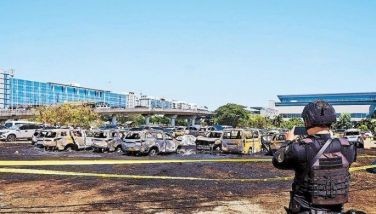What's next in South China Sea? 4 scenarios simulated
MANILA, Philippines — More than 70 analysts from various countries held debates in a bid to simulate the future of the disputed South China Sea.
In a statement earlier this week, consultancy firm Wikistrat examined "key factors" driving instability in the waters claimed by China, the Philippines, Vietnam, Malaysia and Taiwan to come up with "master narratives" or possible scenarios that may affect the region's future.
The factors identified are the increase and interaction of nationalistic sentiment among rival claimants, the course of international diplomacy and ability of negotiators, the desire to control offshore resources and the ongoing buildup of military assets seen in growing defense budgets.
"Examining these four factors, analysts predicted four scenarios for stability and instability in the contested waters," the agency said.
An in-charge Beijing
The first scenario analysts "envisioned" was a more assertive and inward-looking China that causes armed conflict, with the United States stepping back from its proclaimed Asia-Pacific foreign policy rebalance.
Emerging states, which includes the Philippines, may form a coalition "to contain China on their own."
Still, analysts believe ASEAN coalitions will not prevent China from expanding influence as they have a "limited capability to defend themselves" and "spiraling nationalism."
Great powers step back
In this scenario, the US and China both step back, avoiding an armed conflict, and cease to influence littoral states.
Tensions, however, will still remain as maritime rivalries persist due to nationalism and adamant claims to sovereignty.
A US versus China contest
The two superpowers hold a contest over who is going to control regional dynamics in the third scenario. Wikistrat says this situation leads to the "highest prospect for conflict."
"Rising nationalism, an arms buildup in the region, and a mad scramble for natural resources in the disputed waters is expected under this scenario to further draw in Washington and evoke a reciprocal response from Beijing," the agency said.
Best-case scenario
The final possible situation in the region is described as the "best-case" narrative, with China staying true to its rhetoric of peace while the US plays an enduring role in establishing regional order.
China holds back forceful activities in the seas as it prioritizes domestic issues.
Wikistrat also describes this scenario as having maritime resources pursued by all parties without conflict.
In simulating future situations, analysts urge governments to tone down growing nationalism and practice "soft power" to achieve their security goals.
Beijing, meanwhile, has to assure its neighbors of its commitment to peace by pursuing diplomatic means without military might.
"The arms buildup in the region may cause problems for all players," Wikistrat added.
RELATED: China's old maps negate own 'historical' claims over Spratlys
- Latest
- Trending






























